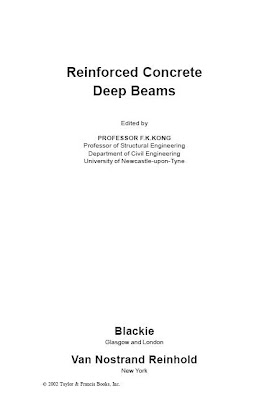This book is designed as an international reference work on the behaviour, design and analysis of reinforced concrete deep beams. It is intended to meet the needs of practising civil and structural engineers, consulting engineering and contracting firms, research institutes, universities and colleges.
Reinforced concrete deep beams have many useful applications, particularly in tall buildings, foundations and offshore structures. However, their design is not covered adequately by national codes of practice: for example the current British Code BS 8110, explicitly states that ‘for design of deep beams, reference should be made to specialist literature’. The major codes and manuals that contain some discussion of deep beams include the American ACI Building Code, the draft Eurocode EC/2, the Canadian Code, the CIRIA Guide No. 2, and Reynolds and Steedman’s Reinforced Concrete Designer’s Handbook. Of these, the CIRIA Guide No. 2: Design of Deep Beams in Reinforced Concrete, published by the Construction Industry Research and Information Association in London, gives the most comprehensive recommendations.
The contents of the book have been chosen with the following main aims: (i) to review the coverage of the main design codes and the CIRIA Guide, and to explain the fundamental behaviour of deep beams; (ii) to provide information on design topics which are inadequately covered by the current codes and design manuals: deep beams with web openings, continuous deep beams, flanged deep beams, deep beams under top and bottom loadings and buckling and stability of slender deep beams; (iii) to give authoritative reviews of some powerful concepts and techniques for the design and analysis of deep beams such as the softened-truss model, the plastic method and the finite element method.
The contributing authors of this book are so eminent in the field of structural concrete that they stand on their own reputation and I feel privileged to have had the opportunity to work with them. I only wish to thank them for their high quality contributions and for the thoroughness with which their chapters were prepared.
I wish to thank Mr A.Stevens, Mr J.Blanchard and Mr E.Booth of Ove Arup and Partners for valuable discussions, and to thank Emeritus Professor R.H.Evans, C.B.E., of the University of Leeds for his guidance over the years. Finally, I wish to thank Mrs Diane Baty for the much valued secretarial support throughout the preparation of this volume.
Learn more about REINFORCED CONCRETE DEEP BEAMS, you can download here
Reinforced concrete deep beams have many useful applications, particularly in tall buildings, foundations and offshore structures. However, their design is not covered adequately by national codes of practice: for example the current British Code BS 8110, explicitly states that ‘for design of deep beams, reference should be made to specialist literature’. The major codes and manuals that contain some discussion of deep beams include the American ACI Building Code, the draft Eurocode EC/2, the Canadian Code, the CIRIA Guide No. 2, and Reynolds and Steedman’s Reinforced Concrete Designer’s Handbook. Of these, the CIRIA Guide No. 2: Design of Deep Beams in Reinforced Concrete, published by the Construction Industry Research and Information Association in London, gives the most comprehensive recommendations.
The contents of the book have been chosen with the following main aims: (i) to review the coverage of the main design codes and the CIRIA Guide, and to explain the fundamental behaviour of deep beams; (ii) to provide information on design topics which are inadequately covered by the current codes and design manuals: deep beams with web openings, continuous deep beams, flanged deep beams, deep beams under top and bottom loadings and buckling and stability of slender deep beams; (iii) to give authoritative reviews of some powerful concepts and techniques for the design and analysis of deep beams such as the softened-truss model, the plastic method and the finite element method.
The contributing authors of this book are so eminent in the field of structural concrete that they stand on their own reputation and I feel privileged to have had the opportunity to work with them. I only wish to thank them for their high quality contributions and for the thoroughness with which their chapters were prepared.
I wish to thank Mr A.Stevens, Mr J.Blanchard and Mr E.Booth of Ove Arup and Partners for valuable discussions, and to thank Emeritus Professor R.H.Evans, C.B.E., of the University of Leeds for his guidance over the years. Finally, I wish to thank Mrs Diane Baty for the much valued secretarial support throughout the preparation of this volume.
Learn more about REINFORCED CONCRETE DEEP BEAMS, you can download here
